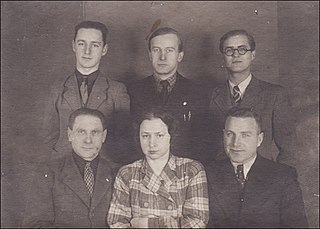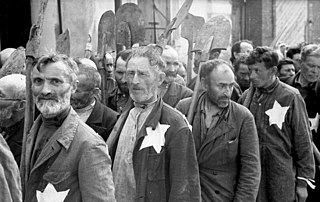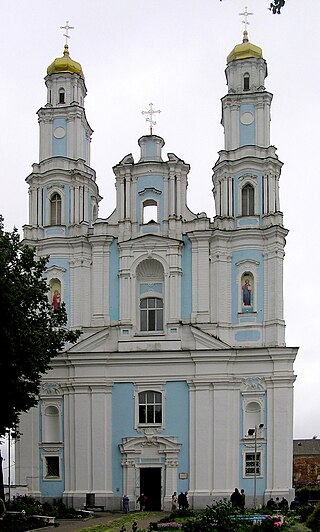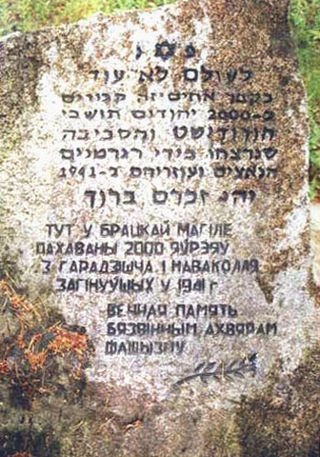
Novogrudok or Navahrudak is a town in Grodno Region, Belarus. It serves as the administrative center of Novogrudok District. As of 2024, it has a population of 27,936.

Hancharowka is a village in Babruysk District, Mogilev Region, Belarus. It is part of Khimy selsoviet.

Ales Prudnikau was a Belarusian poet. He was a cousin of another Belarusian writer, Pavel Prudnikau.

Lyakhchytsy is a village in Kobryn District, Brest Region, Belarus. It is located 15 kilometres (9.3 mi) from Kobryn and 65 kilometres (40 mi) from Brest. It is part of Khidry selsoviet.

Shchadrowshchyna is a village in Belarus. It is located in the Minsk District of Minsk Region, 30 km north of the capital Minsk. The Huyka river begins near the village.

Malik Gabdullin was a Soviet–Kazakh philologist, professor, and writer. A veteran of the Second World War, he was awarded the title Hero of the Soviet Union for his bravery in battle.

Belaruskaya Gazeta was a pro-fascist collaborationist newspaper published in Minsk in the Belarusian language from 27 July 1941 to 28 June 1944 under the control of the German occupation authorities. From its first publication until 5 February 1942 it was called Menskaya Gazeta. It was the largest Belarusian anti-Soviet periodical during the Second World War. The editors of the newspaper were Alexei Senkevich, Uładzisłau Kazłouski, A. Demchenko, Mikołaj Shkelenok and Anton Adamovich. A total of 272 issues were published.

The Mogilev Ghetto was a Nazi ghetto in the city of Mogilev, in eastern Belarus, during World War II. Established shortly following the German victory in the Siege of Mogilev, around 10,000 Jews were killed by the Nazis and collaborationist forces by the time it was abolished in 1943.

The Cathedral of the Nativity of the Virgin is an Orthodox cathedral in the city of Hlybokaye, Vitebsk Region, Belarus. It is located in the historical center of the town on the 17th of September Square. It is the first monument and the most complete expression of the Vilnian Baroque school in Belarus, reflecting "important stages in the development of the artistic principles of the Belarusian Baroque". According to the researcher V. A. Chanturia, this cathedral is a rather peculiar type of religious architecture, because even in Europe temples with four towers of the Baroque period were very rare. Before the reconstruction in the 1730s, it was the only Sarmatian Baroque monument with a transept.

The Ghetto in Baran was a Jewish ghetto, a site of forced relocation for the Jews of Baran in the Orsha District of the Vitebsk Region, and nearby villages, during the persecution and extermination of Jews under the Nazi occupation of Belarus during World War II.

The Holocaust in Baranavichy District refers to the systematic persecution and extermination of Jews in Baranavichy District of Brest Region in Belarus by Nazi Germany and its collaborators from 1941 to 1944 during World War II. This was part of the policy of the "Final Solution to the Jewish Question" and an integral part of the Holocaust in Belarus and the broader genocide of European Jewry.

The Holocaust in Byerazino District refers to the systematic persecution and extermination of Jews in Byerazino District of Minsk Region in Belarus by Nazi Germany and its collaborators from 1941 to 1944, during World War II. This atrocity was part of the broader "Final Solution to the Jewish Question", an integral component of the Holocaust in Belarus and the wider genocide of European Jewry.

The Holocaust in the Byaroza District was the systematic persecution and extermination of Jews in the Byaroza District of the Brest Region by Nazi Germany and its collaborators from 1941 to 1944 during World War II. This atrocity was part of the broader "Final Solution to the Jewish Question", which aimed at the complete annihilation of European Jewry and formed an integral part of the Holocaust in Belarus.

Zhabinka Ghetto was a Nazi Jewish ghetto and a place of forced relocation for the Jews of the town of Zhabinka in the Zhabinka district of the Brest region during the persecution and extermination of Jews under the Nazi occupation of Belarus during World War II.

Hantsavichy Ghetto or GantsevichiGhetto was a Nazi Jewish ghetto, a place of forced relocation for the Jews of the city of Gantsevichi (Hantsavichy) in the Brest Region and nearby settlements during the Holocaust in Belarus under the occupation of Belarus by the forces of Nazi Germany during World War II.

Vysokaye Ghetto was a Nazi Jewish ghetto established during the occupation of Belarus by Nazi Germany in World War II. This ghetto served as a place of forced resettlement for Jews from Vysokaye (Vysoko-Litovsk) in the Kamyenyets District of the Brest region, as well as from nearby settlements, during the Nazi persecution and extermination of Jews.

Vowchyn Ghetto was a Nazi Jewish ghetto established during the Nazi occupation of Belarus in World War II. It was a site of forced resettlement for Jews from Vowchyn in the Kamenets district of the Brest region and surrounding areas, during the persecution and extermination of Jews by Nazi Germany.

Kamyenyets Ghetto was a Nazi Jewish ghetto established during the Nazi occupation of Belarus, served as a place of forced resettlement for Jews from Kamyenyets (Kamyenyets-Litovsky) in the Brest region and nearby settlements. This ghetto was part of the broader persecution and extermination of Jews during World War II.

Motal Ghetto or Motol ghetto was a Jewish ghetto established during the Holocaust in the town of Motal, located in the Ivanava Raion of the Brest region, Belarus. This ghetto was a site of forced relocation for Jews from Motol and nearby settlements during the Nazi occupation of Belarus in World War II.

Davyd-HaradokGhetto was a Jewish ghetto established during World War II in the town of Davyd-Haradok, located in the Stolin district of the Brest region. This ghetto served as a place of forced resettlement for Jews from Davyd-Haradok and nearby settlements during the Nazi occupation of Belarus.






















